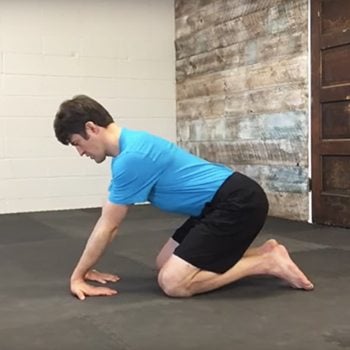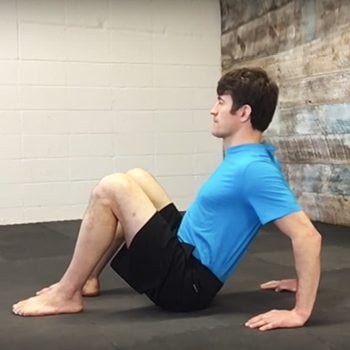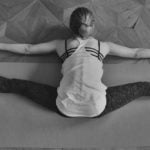You’ve been bitten by the bug. Ever since you started Brazilian Jiu Jitsu (BJJ), it’s all you think about.
Avid BJJ practitioners say the same thing about their sport: “BJJ is addictive.” But you know this. Once you’re hooked on BJJ, the only thing that’s gonna keep you off the mats is an injury.
And boy, do injuries abound in BJJ!
In this guide, we’ll talk about some of the most common concerns for BJJ practitioners, and we’ll give you a routine to address some of those concerns. That way, you can avoid BJJ injuries and spend a lot more time on the mats.
Here’s what we’ll cover in this article:
- Our backgrounds in BJJ
- The 5 most common BJJ injuries
- BJJ mobility routine
- A complement to your BJJ practice
We’re a Bunch of BJJ Addicts Ourselves

Here are Jarlo and Rachel in a fierce BJJ battle 😉
Our clients are involved in a wide variety of sports and activities, but BJJ is probably the most common activity we hear about. And that makes sense for a couple of reasons:
- The types of movements we teach can be very beneficial as part of a BJJ practice.
- We’re pretty well-versed in BJJ ourselves.
Jarlo, one of my co-founders, has been practicing BJJ since 2004, and is a brown belt under Burton Richardson. I’ve been practicing many different types of grappling arts for years (I hold a black belt in Judo, amongst other arts), but I got started with BJJ a couple of years ago, and am now a brown belt.
Many of our trainers have experience with BJJ, and even a bunch of our staff members practice BJJ–including Rachel (content manager), Jeff (trainer & client support), Chris (coach), Andy (video editor), and Stacey (admin).
Why am I telling you all this?
Because we don’t just recommend what I’ll talk about in this article. We use it ourselves and know it works.
The 5 Most Common BJJ Injuries

My son and I “beating up” our professor. You don’t just recover from these kinds of injuries overnight!
BJJ is a physically demanding sport that can strain most of the body in one way or another if you’re not careful or don’t have a good foundation (or, let’s face it, if you’re paired with that one white belt who seems intent on killing his sparring partners).
Here are the 5 most common injury and limitation areas that can keep BJJ practitioners off the mats, or stall their progress (the routine below will help address all of these):
1. Wrists/Hands
This is especially problematic if you practice Gi, but weak hands, fingers, and/or wrists can certainly get in your way with no-Gi as well. With Gi, though, if your grip is not strong enough, you leave yourself open to injuries.
We’ve all seen that guy with 37 layers of tape around his fingers. Don’t be that guy.
2. Hips
Tight hips are one of the more annoying issues to have in BJJ. They get in the way of shrimping out of positions, throwing a good triangle on an opponent, and even closing your guard tightly. For some people, just showing up and practicing the positions frequently can be enough to overcome tightness, but if you’ve had tight hips for a long time, that probably won’t cut it.
3. Shoulders
The shoulders are one of the most commonly injured areas in BJJ. Sure, this is often due to not tapping soon enough (tsk tsk), but sometimes there just isn’t time. And if you have really tight shoulders, even the slightest amount of force in an Americana or Kimura can wreak havoc on your joints.
But if you start working on your shoulder mobility now, in a couple of months, you just might get bragging rights for withstanding that nasty submission that always gets you.
Improve your shoulder mobility.
4. Neck
Neck injuries can be pretty awful, and can put you out of commission for a long time, especially if it comes from force, such as falling improperly in a takedown. It’s important to keep your neck strong and moving well so that you don’t wind up in trouble down the line.
5. Ankles
If you want to hold a tight guard position–you know, the type of guard that makes your opponent’s face turn red from frustration–you need strong ankles that can withstand pressure. And they need to be mobile enough to bend easily so that you can avoid injuries from ankle or foot locks.
The last thing you want is an ankle injury that puts you out of commission for any extended period of time.
BJJ Mobility Routine
The following routine will help you build the mobility and strength you need for your BJJ practice. Working on this routine will help you prevent the 5 most common BJJ injuries we just discussed. There are a few other common BJJ injuries like rib and knee injuries, but this routine will specifically focus on the above limitations.
One thing you’ll notice with this routine is a strong emphasis on motor control, where we combine movements and work on improving the control we have over those movements. This is an essential part of a strong BJJ practice.
Let’s take a look at the details for each of these exercises.
Forearm/Wrist Stretch

- Start on your hands and knees and rotate your wrists so that your palms are on the ground with your fingers pointing toward your knees.
- Keeping your elbows locked out, press into the ground as you move your butt back toward your heels.
- You should feel a nice stretch in your wrists and forearms as you move backward, but don’t move into any ranges that are painful for you.
- Move in and out of the stretch 10 times, then hold the last rep for 15-30 seconds.
Lounge Chair Stretch

- Sit on the ground with your hands placed comfortably behind you, with your fingers pointing toward your butt.
- Keep your chest up and squeeze your shoulder blades together, with your elbows pointing backward. The dynamic action is squeezing the shoulder blades together while pushing down through your hands and breathing in deeply.
- Contract and relax in this way 10 times, then hold the last rep for 15-30 seconds.
Sit Through to Frog Stretch

- Start on all fours, then lift your left leg up and plant the foot on the ground as you bring your right foot through to rest momentarily on your right hip.
- Continue the rotation until you are in a frog stretch position, with your knees as wide as they can comfortably go.
- Drop your elbows down to the ground and relax into the stretch for 15 seconds.
- Come up onto your hands and knees and repeat the motion on the opposite side.
- Do 5-10 reps of this sequence.
Quadruped Twist to Roll to Plow

- Start on all fours, then place your left elbow down on the ground and bend your right arm behind your back. Squeeze the right shoulder blade and twist your body toward the right so that you are looking up at the ceiling.
- Do 10 reps, then guide the left arm along your body as you roll on the back of your neck into a plow position.
- Hold the plow position for 15 seconds, then roll in the opposite direction and repeat on the other side.
- Do 5 reps of this sequence.
Kneeling Lunge to Modified Pigeon to Squat

- Start in a kneeling lunge position, with one knee up and one knee down.
- Squeeze the glute of the rear leg to feel a stretch in that side hip flexor.
- Move in and out of the stretch 10 times, then hold for 15-30 seconds.
- Then, drop the front leg to the ground so that it is bent at a 90-degree angle in front of you. Let the back leg bend however is comfortable for you.
- Keep your chest up and your hips square. Hinge from the hips and pull your body forward over your leg. The dynamic action is pushing the side of your lower leg into the ground.
- Move in and out of the stretch 10 times, then hold for 15-30 seconds.
- Come up into a squat and relax there (at whatever depth is comfortable for you) for 15-30 seconds.
- Repeat the sequence on the other side.
How to Use This BJJ Mobility Routine
First, here’s a recap of the routine:
| Exercise | Sets/Reps |
|---|---|
| 1. Forearm/Wrist Stretch | • 10 reps, followed by 15-30 second hold |
| 2. Lounge Chair Stretch | • 10 contractions, followed by 15-30 second hold |
| 3. Sit Through to Frog Stretch | 5-10 rounds of the sequence: • 1 sit through into frog stretch • Hold frog stretch for 15 seconds on each round |
| 4. Quadruped Twist to Roll to Plow | 5 rounds of the sequence: • 10 reps of quadruped twist, then roll into plow • Hold plow for 15 seconds |
| 5. Kneeling Lunge to Modified Pigeon to Squat | • 10 contractions in kneeling lunge, followed by 15-second hold • 10 contractions in modified pigeon, followed by 15-second hold • 15-30 seconds in squat |
This routine should act as a guide for your individual situation and daily practice. It may be used a warm-up routine or perhaps a cool down after a hard class. If you’re low on time and are dealing with a particular limitation, pick two or three exercises that feel best for you.
For instance, if neck weakness is an issue for you, working on the Quadruped Twist to Roll to Plow will be highly beneficial for you.
If tight hips are holding you back, you won’t want to skip the Sit Through to Frog Stretch.
Whatever your daily practice looks like, start implementing these exercises in a way that will help your practice and your performance, and will protect you from the injuries you’re most concerned about.
A Complement to Your BJJ Practice
Getting regular movement through unusual positions can be extremely helpful in improving your BJJ performance–after all, you never know what kind of crazy positions you might find yourself in, right?
And when you move through many different positions, you condition your body to be resilient in unexpected situations.
If you want to move with great ease and control on the mats–or in any other activity–Elements will hep you do that.
Start Moving Better on the Mats (and Off!)
With Elements, you’ll learn to move with better control and mobility, which will help you improve your BJJ technique (and more!).






